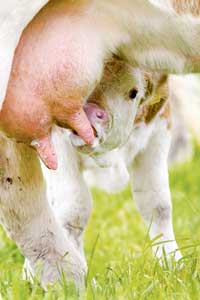Supplement cow feed to prevent grass staggers

The effects of the long, harsh winter could show themselves this spring in the form of increased staggers in adult cattle and higher levels of scours in calves, warns vet Keith Cutler, Endell Vet Group.
Grass staggers
Cows are unable to store magnesium internally, so must be provided with sufficient levels in the diet. However, when grass is lacking – which may be the case in many areas of the country – cows are not able to get sufficient levels from grazing alone.
Also, when grass becomes lush following a sudden period of warm weather, cows may scour, preventing adequate absorption of magnesium. When this is the case, cows may develop hypomagnesemia or grass staggers.
“We are seeing staggers in beef and dairy cows, but more so in beef animals because they are not receiving supplementary feed,” Mr Cutler says.
And to help prevent the onset of grass staggers, a milking cow producing 20 litres a day should be provided with 30g of magnesium a day, says vet Neil Howie, Nantwich Vet Group.
“Cows in negative energy balance are more prone to staggers, so it’s the low yielding cows, milking purely off grass, that are more likely to develop problems.”
When cows are being fed a TMR, magnesium should be included in the mix, says Mr Cutler.
And when animals are not receiving supplementation, the most certain way of ensuring cows are receiving enough magnesium is through mineral boluses. “Boluses may be a hassle, but they are cheap and effective,” he says.
“You are guaranteeing each cow is receiving a set amount of magnesium that will be effective for about three months.”
When producers are not prepared to bolus, magnesium can also be administered through magnesium chloride flakes in drinking water and/or lick blocks.
And with some suckler cows calving down in poor condition, calf health is also suffering.
Calf Health
“Because cows are below ideal condition, colostrum quality and volume is suffering, resulting in increased levels of coronovirus and rotovirus in calves this year,” explains Mr Cutler.
“It is essential young calves receive enough colostrum early on as scouring will significantly impact future performance,” he says.
It may be worth having a supply of artificial colostrum on stand-by, says Mr Howie.
“When you expect colostrum quality or volume to be poor, consider topping up the dam’s supply by tubing calves with two litres of artificial colostrum.
“However, tubed calves absorb half as many antibodies as suckled calves, so it is important to weigh up the pros and cons before going down this route,” he stresses.
And vaccinating adult cattle for rotovirus and coronavirus can be an effective way of raising colostrum antibody levels and thus quality, says Mr Cutler.
“It is expensive to vaccinate every cow for these diseases every year, but this year it may be worth considering – as long as cows are at least 3-4 weeks away from calving,” he says.
However, to ensure vaccines are effective, it is essential cows receive adequate vitamins and minerals in the run-up to calving, says Mr Howie.
“When cows are lacking in vitamins and minerals, or not receiving enough protein close to calving, they will be unable to produce sufficient antibodies in response to the vaccine.”
